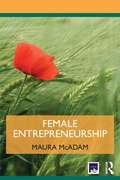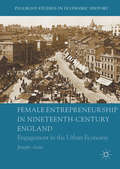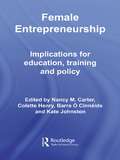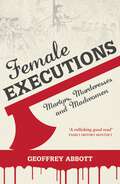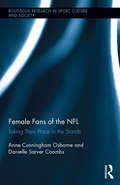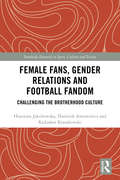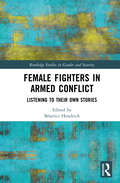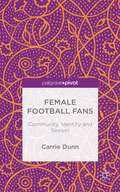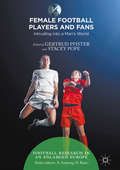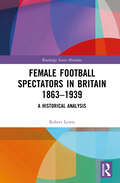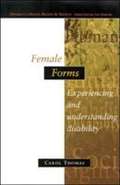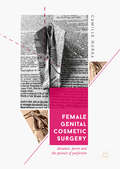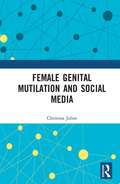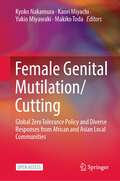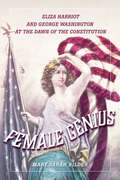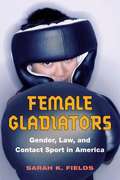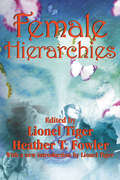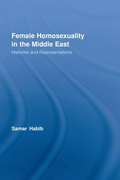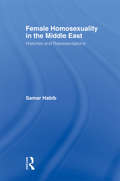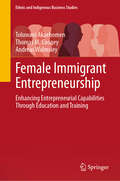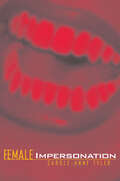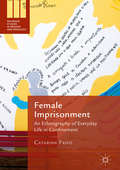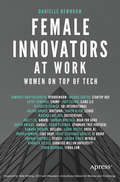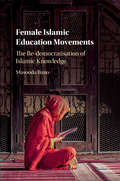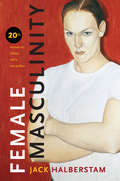- Table View
- List View
Female Entrepreneurship (Routledge Masters in Entrepreneurship)
by Maura McAdamFemale entrepreneurship, and, in particular, the contribution of their ventures to aggregate economic activity has gained increasing attention over recent years in terms of theory, practice and policy. This concise book explores how women fit into the contemporary entrepreneurial discourse by recognizing that gender intersects with, and influences, women’s experience of entrepreneurship. The book is novel in that it considers women to be a heterogeneous group and as such acknowledges that ethnicity, culture, class and education will all influence and intersect with female entrepreneurship. As a consequence, it explores issues ranging from theoretical relationships between the constructs of gender and entrepreneurship to more empirical work on how entrepreneurship might act as an empowering change agent for women. In order to address the Euro-US centric assumptions underpinning the influence of gender upon entrepreneurship, a chapter is dedicated to the role of entrepreneurship in empowering Palestine women. This book will be important supplementary reading on entrepreneurship, small business management and women's/gender studies courses - it will prove particularly useful to women moving towards starting their own business as well as postgraduate students researching the topic for the first time.
Female Entrepreneurship in Nineteenth-Century England
by Jennifer AstonAston challenges and reshapes the on-going debate concerning social status, economic opportunity, and gender roles in nineteenth-century society. Sources including trade directories, census returns, probate records, newspapers, advertisements, and photographs are analysed and linked to demonstrate conclusively that women in nineteenth-century England were far more prevalent in business than previously acknowledged. Moreover, women were able to establish and expand their businesses far beyond the scope of inter-generational caretakers in sectors of the economy traditionally viewed as unfeminine, and acquire the assets and possessions that were necessary to secure middle-class status. These women serve as a powerful reminder that the middle-class woman's retreat from economic activity during the nineteenth-century, so often accepted as axiomatic, was not the case. In fact, women continued to act as autonomous and independent entrepreneurs, and used business ownership as a platform to participate in the economic, philanthropic, and political public sphere.
Female Entrepreneurship: Implications for Education, Training and Policy (Routledge Advances in Management and Business Studies #Vol. 14)
by Nancy M. Carter Colette Henry Kate Johnston Barra O. CinneideThis informative book is a comprehensive, research-based text on for educators, trainers and policy makers. It provides an insightful analysis into the range of issues facing female entrepreneurs around the world, along with recommendations as to how support agencies, educators and trainers can best respond to the challenge of encouraging more women to get involved in the new business creation. Based on a collection of research papers from international scholars based in the UK, mainland Europe, the USA and Australia, it provides a superbly comprehensive analysis of the challenges and opportunities faced by female entrepreneurs worldwide. With contributors from Sara Carter, Candida Brush, John Watson and Elisabet Ljunggren, the book helps advance the general understanding of female entrepreneurship and helps set a research agenda on how best to promote female owned/led businesses nationally and internationally.
Female Executions: Martyrs, Murderesses and Madwomen
by Geoffrey AbbottFrom the highwayman who held up coaches with just her fists, to the woman who survived the gallows and took her empty coffin away with her, Female Executions illuminates history’s darker periods. Grimly funny and interspersed with unusual last requests and black and white illustrations throughout, this is history at its most morbidly fascinating.
Female Fans of the NFL: Taking Their Place in the Stands (Routledge Research in Sport, Culture and Society #49)
by Anne Cunningham Osborne Danielle Sarver CoombsIn the past, sport, particularly football, has been defined as a male domain. Women’s interest stereotypically ranges from gentle tolerance to active resistance. But increasingly, women are proudly identifying themselves as supporters of their teams, and have become highly desirable audiences for sport organizations and merchandisers. Football provides a unique site at which to examine the complex interplay between three theoretical areas: identity formation and maintenance, commercialization of cultural practices, and gender hegemony. This book explores how women experience their fandom, and what barriers exist for the female fan.
Female Fans, Gender Relations and Football Fandom: Challenging the Brotherhood Culture (Routledge Research in Sport, Culture and Society)
by Honorata Jakubowska Radoslaw Kossakowski Dominik AntonowiczThis book assesses the transformation of football fan culture from a gender perspective. Referring to the notions of homosociality, hegemonic masculinity and performative perspectives on gender and fandom, it investigates the processes of women entering the world of football fandom. Drawing on multidimensional qualitative and quantitative research, the book analyses different aspects of female fandom, such as women’s socialisation to be a fan, building their sense of fan identity, ways of performing fandom, and gender. Also, it explores the response of male fans by shedding light on the sense-making process of a growing number of female fans in the stands and its consequences for prevailingly male football culture. This study stands out for its richness and diversity of empirical material used in order to make a significant contribution to our understanding of social dynamics related to the changing nature of female football fandom. The book is fascinating reading for researchers and students in a broad range of areas, including gender studies, sociology of sport, football, women’s studies and Central Eastern European studies. It is also a valuable resource for scholars, and football and club authorities who have an interest in understanding the development of female football fandom and its impact on the male fandom community.
Female Fighters in Armed Conflict: Listening to Their Own Stories (Routledge Studies in Gender and Security)
by Béatrice HendrichThis book explores the why and the how of women’s participation in armed struggle, and challenges preconceived assertions about women and violence, providing both a historic and a contemporary focus. The volume is about women who have participated in armed conflict as members of an armed group, trained in military action, with different tasks within the conflict. The chapters endeavor to make women’s own voices heard, to discover the untold stories of women as perpetrators and facilitators of military violence, and the authors do this through the use of personal interviews and the study of primary documents. The work widens the geographical perspective of feminist security studies to discover in what ways the historical, political, and social context has motivated the women to participate in military action, and presents new case study data from Germany, Ukraine, Turkey, Israel, Palestine, Cameroon, India, the Philippines, Vietnam and Latin America. Temporally, the chapters cover almost two centuries, from the late 19th century to the present day, touching upon a wide variety of examples of armed conflict, from wars of independence to the Second World War. Bringing together approaches from politics, history, anthropology and area studies, the chapters are informed by the fundamental insights of feminist research and address such pivotal questions as hegemonic masculinity in the armed forces and the relation between women’s armed violence and female agency. This book will be of much interest to students and researchers in gender and security studies, armed conflict and history.
Female Football Fans: Community, Identity and Sexism
by Carrie DunnMost sociological work on football fandom has focused on the experience of men, and it usually talks about alcohol, fighting and general hooliganism. This book shows that there are some unique facets of female experience and fascinating negotiations of identity within the male-dominated world of men's professional football.
Female Football Players and Fans
by Gertrud Pfister Stacey PopeThis volume draws upon social science and historical approaches to provide insights into the world of women’s football and female fans. It gives an in-depth analysis of the development of the women’s game in different European countries and examines the experiences of female fans. An overview about women’s football in Europe shows the rise and development of the game and the increasing inclusion of girls and women in football and fan communities. To date, there has been a lack of research on female participation in football, but drawing on research studies from various European countries, the volume explores a range of issues, including how girls and women become football fans and players, how women combine football with their everyday lives, and how they may encounter stereotypes and barriers when they challenge male dominance by entering this traditionally male sport. This collection will be of interest to students and scholars in a range of fields, including sports sociology, sport sciences, gender studies, leisure studies, women’s studies as well as fandom and cultural studies.
Female Football Spectators in Britain 1863-1939: A Historical Analysis (Routledge Soccer Histories)
by Robert LewisThis book analyses women as spectators at men’s association football (soccer) in Britain from 1863 to 1939. The author shows that women have always been present at men’s football in Britain, a fact not always acknowledged in modern popular accounts of the game, albeit as a small minority in overall attendances. Some women have always been ‘authentic’ fans of football, both knowledgeable and enthusiastic in their support, and this book will demonstrate that.
Female Forms: Experiencing and Understanding Disability
by Carol Thomas* What is the relevance of feminist ideas for understanding women's experiences of disability? * How can the social model of disability be developed theoretically? * What are the key differences between Disability Studies and medical sociology? In answer to these questions, this book explores and develops ideas about disability, engaging with important debates in disability studies about what disability is and how to theorize it. It also examines the interface between disability studies, women's studies and medical sociology, and offers an accessible review of contemporary debates and theoretical approaches. The title Female Forms reflects two things about the book: first, its use of disabled women's experiences, as told by themselves, to bring a number of themes to life, and second, the author's belief in the importance of feminist ideas and debates for disability studies. The social model of disability is the book's bedrock, but the author both challenges and contributes to social modelist thought. She advances a materialist feminist perspective on disability, producing a book which is of multi-disciplinary relevance. Female Forms will be useful to the growing number of students on Disability Studies courses, as well as those interested in women's studies, medical sociology and social policy. It will also appeal to those studying or working in the health and social care professions such as nursing, social work, occupational therapy and physiotherapy.
Female Genital Cosmetic Surgery: Deviance, Desire and the Pursuit of Perfection
by Camille NurkaExamining the fascinating history of female genital cosmetic surgery, Camille Nurka traces the origins of contemporary ideas of genital normality. Over the past twenty years, Western women have become increasingly worried about the aesthetic appearance of their labia minora and are turning to cosmetic surgery to achieve the ideal vulva: a clean slit with no visible protrusion of the inner lips. Long labia minora are described by medical experts as ‘hypertrophied,’ a term that implies deformity and the atypical. But how far back does the diagnosis of labial hypertrophy go, and where did it originate? Female Genital Cosmetic Surgery tells the story of the female genitalia from the alien world of ancient Greek gynaecology to the colonial period of exploration and exploitation up to the present day. Bringing together historical, medical, and theoretical documentation and commentary, Nurka uncovers a long tradition of pathologizing female anatomy, a history sure to be of interest to any reader who wishes to know more about how medicine shapes our commonly held ideals.
Female Genital Mutilation and Social Media
by Christina JuliosThis book explores the phenomenon of anti-femail genital mutilation (FGM) social media activism. Against a backdrop of over 200 million girls and women worldwide affected by FGM, this volume examines key global online campaigns to end the practice, involving leading virtual platforms such as Twitter, Facebook and YouTube. Drawing from twenty-one fieldwork interviews with anti-FGM activists, frontline practitioners and survivors, the volume investigates opportunities and challenges inherent to cyberspace. These include online FGM bans as well as practices such as ‘cyber-misogyny’ and ‘clicktivism’. Global campaigns featured include the UN’s International Day of Zero Tolerance for FGM, the WHO’s Sexual and Reproductive Health Programme, The Girl Generation, The Guardian’s End FGM Global Media Campaign and the Massai Cricket Warriors. Furthermore, ten case-studies document prominent anti-FGM campaigners. Firstly, five African-led narratives from celebrated activists: Efua Dorkenoo OBE, Waris Dirie, Ayaan Hirsi Ali, Jaha Mapenzi Dukureh and Leyla Hussein. Second, five accounts from FGM survivors interviewed for the book: Mama Sylla, Masooma Ranalvi, Farzana Doctor, Fatou Baldeh and Mariya Taher. By exploring anti-FGM online activism, this book fills a gap in the literature which has largely overlooked FGM’s presence in cyberspace as a virtual social movement. Female Genital Mutilation and Social Media will be of interest to activists, survivors, frontline professionals, students, academics and the wider public.
Female Genital Mutilation/Cutting: Global Zero Tolerance Policy and Diverse Responses from African and Asian Local Communities
by Kyoko Nakamura Kaori Miyachi Yukio Miyawaki Makiko TodaThis open access book shows how the adoption of global justice, such as eradication of female genital mutilation/cutting (FGM/C), has given rise to controversy, resistance, and transformation at the national, regional, and grass-roots levels in African and Asian countries where FGM/C has been practiced. It provides readers with up-to-date information about the effects of the campaign to eradicate FGM/C and the present situation of those countries, to which preceding books on FGM/C have scarcely referred. Adopting “zero tolerance” as a policy of eradication, WHO and other UN agencies have opposed any type of FGM/C, and many African countries have criminalized the practice. Although the campaign is based on the human rights discourse which is shared globally, the controversies concerning eradication of FGM/C on the national level and the responses of communities on the local level in those countries are diverse and complicated. Various actors such as NGOs, government officials, religious leaders, medical workers, and local inhabitants are embroiled and negotiate with each other concerning its eradication.With this book, readers are provided with an in-depth analysis of the complicated controversies and responses of local communities, referring to their particular historical and social backgrounds. The book provides two chapters on FGM/C in Asian countries, where not many studies have done yet. It also presents readers with a study of the arguments and responses to FGM/C of African immigrants by Australian health-care professionals as well as a study of male circumcision eradication campaigns, which have been carried on in tandem with FGM/C eradication campaigns but still not have been successful. With its many elaborate case studies, this book is highly recommended to readers who seek an in-depth and up-to-date integrated overview of the FGM/C studies as well as studies on the applicability of global justice to local communities.
Female Genius: Eliza Harriot and George Washington at the Dawn of the Constitution
by Mary Sarah BilderIn this provocative new biography, Mary Sarah Bilder looks to the 1780s—the Age of the Constitution—to investigate the rise of a radical new idea in the English-speaking world: female genius. Bilder finds the perfect exemplar of this phenomenon in English-born Eliza Harriot Barons O’Connor. This pathbreaking female educator delivered a University of Pennsylvania lecture attended by George Washington as he and other Constitutional Convention delegates gathered in Philadelphia. As the first such public female lecturer, her courageous performance likely inspired the gender-neutral language of the Constitution.Female Genius reconstructs Eliza Harriot’s transatlantic life, from Lisbon to Charleston, paying particular attention to her lectures and to the academies she founded, inspiring countless young American women to consider a college education and a role in the political forum. Promoting the ideas made famous by Mary Wollstonecraft, Eliza Harriot brought the concept of female genius to the United States. Its advocates argued that women had equal capacity and deserved an equal education and political representation. Its detractors, who feared it undermined male political power, felt deeply threatened. By 1792 Eliza Harriot experienced struggles that reflected the larger backlash faced by women and people of color as new written constitutions provided the political and legal tools for exclusion based on sex, gender, and race.In recovering this pioneering life, the richly illustrated Female Genius makes clear that America’s framing moment did not belong solely to white men and offers an inspirational transatlantic history of women who believed in education as a political right.
Female Gladiators: Gender, Law, and Contact Sport in America
by Sarah K. FieldsFemale Gladiators examines the legal and social history of the right of women to participate with men in contact sports. The impetus to begin legal proceedings was the 1972 enactment of Title IX, which prohibited discrimination in educational settings, but it was the Equal Protection Clause of the U.S. Constitution and the equal rights amendments of state constitutions that ultimately opened doors. Despite court rulings, however, many in American society resisted--and continue to resist--allowing girls in dugouts and other spaces traditionally defined as male territories. When the leagues continued to bar girls simply because they were not boys, the girls went to court. Sarah K. Fields examines the legal and cultural conflicts over gender and contact sports that continue to rage today.
Female Hierarchies
by Lionel TigerDisproportionate attention has long been paid to males in human and other social systems. The basic structures used to explain social behavior in sociological and biological work have overwhelmingly emphasized the significance and shape of male behavior and far less female behavior which is surely at least as important. Stratification, sexual selection, and natural selection of what women do among themselves and how they relate to men was explored in this volume for the first time. It is now available in a paperback edition, with a new introduction by Lionel Tiger. Do females conduct aggressive encounters with each other? Or do they have no impact on mate selection and hence on the future of the genotype? Is the main negotiation of females with males and not among themselves during this selective process? Do the usually larger size and frequently more elaborate behavioral displays of males betray the fact that the burden of selective functioning falls on males and not on females? It is improbable that the answer to these questions is "yes" and that there is little or nothing happening in all-female groups that affects not only how their communities operate but, more importantly in the long run, the genotype of their species. For those species in which gregarious social behavior is a sine qua non for successful reproduction, what are the principles of selection that operate through females? Are female hierarchies more abrasive or generous than male ones? Do they focus more on reproduction than production? What are the forms of female social grouping that either support, modify, inhibit, or stimulate sexual and hence natural selection? This work goes far beyond the slogans of our time for important responses to basic questions.
Female Homosexuality In The Middle East
by Samar Habib<P>This book, the first full-length study of its kind, dares to probe the biggest taboo in contemporary Arab culture with scholarly intent and integrity - female homosexuality. <P>Habib argues that female homosexuality has a long history in Arabic literature and scholarship, beginning in the ninth century, and she traces the destruction of Medieval discourses on female homosexuality and the replacement of these with a new religious orthodoxy that is no longer permissive of a variety of sexual behaviours. <P>Habib also engages with recent "gay" historiography in the West and challenges institutionalized constructionist notions of sexuality.
Female Homosexuality in the Middle East: Histories and Representations (Routledge Research in Gender and Society)
by Samar HabibThis book, the first full-length study of its kind, dares to probe the biggest taboo in contemporary Arab culture with scholarly intent and integrity - female homosexuality. Habib argues that female homosexuality has a long history in Arabic literature and scholarship, beginning in the ninth century, and she traces the destruction of Medieval discourses on female homosexuality and the replacement of these with a new religious orthodoxy that is no longer permissive of a variety of sexual behaviours. Habib also engages with recent "gay" historiography in the West and challenges institutionalized constructionist notions of sexuality.
Female Immigrant Entrepreneurship: Enhancing Entrepreneurial Capabilities Through Education and Training (Ethnic and Indigenous Business Studies)
by Andreas Walmsley Thomas M. Cooney Toluwani AkaehomenThis groundbreaking monograph explores the urgent need for tailored support systems that empower female immigrant entrepreneurs to navigate the complex challenges and unlock the opportunities they encounter in their host countries. Anchored in the Andragogy-in-Practice framework, the book critically examines the alignment between existing Entrepreneurship Education and Training provision and the entrepreneurial needs of female immigrants, drawing on qualitative research conducted in the Irish context. It highlights the systemic gaps in current training offerings while showcasing the potential of adult learning principles to foster inclusive, culturally responsive education. Offering both academic insight and practical guidance, this volume serves as a valuable resource for educators, trainers, policymakers, and support organisations. It provides a clear, evidence-based roadmap for designing and delivering impactful programmes that recognise and build upon the unique strengths, aspirations, and lived experiences of this often underrepresented yet economically vital group.
Female Impersonation
by Carol-Anne TylerA feminist and psychoanalytic investigation of the contemporary fascination with impersonation. The questions raised by female impersonations in a wide range of contemporary media are considered.
Female Imprisonment
by Catarina FroisThis book is a reflection on the nature of confinement, experienced by prison inmates as everyday life. It explores the meanings, purposes, and consequences involved with spending every day inside prison. Female Imprisonment results from an ethnographic study carried out in a small prison facility located in the south of Portugal, and Frois uses the data to analyze how incarcerated women talk about their lives, crimes, and expectations. Crucially, this work examines how these women consider prison: rather than primarily being a place of confinement designed to inflict punishment, it can equally be a place of transformation that enables them to regain a sense of selfhood. From in-depth ethnographic research involving close interaction with the prison population, in which inmates present their life histories marked by poverty, violence, and abuse (whether as victims, as agents, or both), Frois observes that the traditional idea of "doing time", in the sense of a strenuous, repressive, or restrictive experience, is paradoxically transformed into "having time" - an experience of expanded self-awareness, identity reconstruction, or even of deliverance. Ultimately, this engaging and compassionate study questions and defies customary accounts of the impact of prisons on those subjected to incarceration, and as such it will be of great interest for scholars and students of penology and the criminal justice system.
Female Innovators at Work
by Danielle NewnhamThis book describes the experiences and successes of female innovators and entrepreneurs in the still largely male-dominated tech-world in twenty candid interviews. It highlights the varied life and career stories that lead these women to the top positions in the technology industry that they are in now. Interviewees include CEOs, founders, and inventors from a wide spectrum of tech organizations across sectors as varied as mobile technology, e-commerce, online education, and video games. Interviewer Danielle Newnham, a mobile startup and e-commerce entrepreneur herself as well as an online community organizer, presents the insights, instructive anecdotes, and advice shared with her in the interviews, including stories about raising capital for one's start-up, and about the obstacles these women encountered and how they overcame them. This timely book will be of great interest to anyone working in tech or looking to get into the industry, and more in general: to everyone wanting to learn how they can contribute to leveling the field of occupational opportunity and to strengthening teams and companies through merit and diversity.
Female Islamic Education Movements: The Re-democratisation of Islamic Knowledge
by Masooda BanoSince the 1970s, movements aimed at giving Muslim women access to the serious study of Islamic texts have emerged across the world. In this book, Masooda Bano argues that the creative spirit that marked the rise and consolidation of Islam, whereby Islam inspired serious intellectual engagement to create optimal societal institutions, can be found within these education movements. Drawing on rich ethnographic material from Pakistan, northern Nigeria and Syria, Bano questions the restricted notion of agency associated with these movements, exploring the educational networks which have attracted educated, professional and culturally progressive Muslim women to textual study, thus helping to reverse the most damaging legacy of colonial rule in Muslim societies: the isolation of modern and Islamic knowledge. With its comparative approach, this will appeal to those studying and researching the role of women across Africa, the Middle East and South Asia, as well as the wider Muslim world.
Female Masculinity
by Jack HalberstamIn this quintessential work of queer theory, Jack Halberstam takes aim at the protected status of male masculinity and shows that female masculinity has offered a distinct alternative to it for well over two centuries. Demonstrating how female masculinity is not some bad imitation of virility, but a lively and dramatic staging of hybrid and minority genders, Halberstam catalogs the diversity of gender expressions among masculine women from nineteenth-century pre-lesbian practices to contemporary drag king performances. Through detailed textual readings as well as empirical research, Halberstam uncovers a hidden history of female masculinities while arguing for a more nuanced understanding of gender categories that would incorporate rather than pathologize them. He rereads Anne Lister's diaries and Radclyffe Hall's The Well of Loneliness as foundational assertions of female masculine identity; considers the enigma of the stone butch and the politics surrounding butch/femme roles within lesbian communities; and explores issues of transsexuality among “transgender dykes”—lesbians who pass as men—and female-to-male transsexuals who may find the label of “lesbian” a temporary refuge. Halberstam also tackles such topics as women and boxing, butches in Hollywood and independent cinema, and the phenomenon of male impersonators. Featuring a new preface by the author, this twentieth anniversary edition of Female Masculinity remains as insightful, timely, and necessary as ever.
